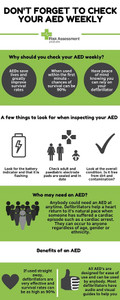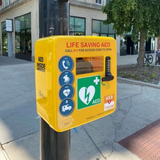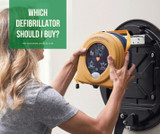How often should a defibrillator (AED) be checked?
An automatic external defibrillator (AED) is a medical device that is used on people who have suffered a sudden cardiac arrest. They work by scanning the heart to determine whether a shock is needed. If a shock is needed, the AED will deliver one automatically, in turn helping the heart return to it’s normal rhythm.
You can find a defibrillator in many public places including; supermarkets, sports facilities, schools, offices, warehouses, sports facilities and more. Depending on where they are located depends on how they are stored. There are a range of internal and external cases available which have different IP ratings that mean they can withstand different levels of water and dust corrosion.
As defibrillators are such life saving tools, it’s really important to ensure they are looked after properly. When someone suffers a cardiac arrest, their chances of survival reduce drastically with every minute that passes. If you are fortunate enough to have a defibrillator close by, it’s really important to ensure you know that it is going to work.
Carrying out regular inspections of your AED means that you always have peace of mind when thinking about when you may need to use it. Although the majority of defibrillators carry out daily self checks to ensure everything is in order, it is still good practice to conduct weekly checks on your defibrillator yourself.
An easy and straightforward way to ensure checks on your defibrillator are always carried out are through AED inspection records. If you have a defibrillator in your workplace, it is a good idea to allocate this task to somebody, making it their weekly responsibility. This way you have the peace of mind knowing it will always be checked.
On defibrillator inspection records you will more than likely be required to record where the defibrillator is located, the condition of it (whether it is free from contaminants such as dirt), checking it is on standby mode, ensuring the spare electrode pads sealed and in date and that there are accessories present such as face towel, razor and disposable gloves for example.
Ensuring you check your AED once a week is a quick and simple task that should be carried out but, rest assured should you need to use it, you know everything is in order.
If you'd like to download our AED Weekly Inspection Record PDF click here.
Recent Posts
-
Empowering Communities: The Lifesaving Impact of CPR on Restart a Heart Day
Every year, on and around October 16th, an important event takes place - Restart a Heart Day. This a …16th Oct 2023 -
Which home defibrillator?
80% of all out of hospital cardiac arrests occur at home. Defibrillators are often available in loca …4th Dec 2022 -
Which defibrillator should I buy?
There are many defibrillators available on the market and it can become overwhelming knowing which o …4th Nov 2022




